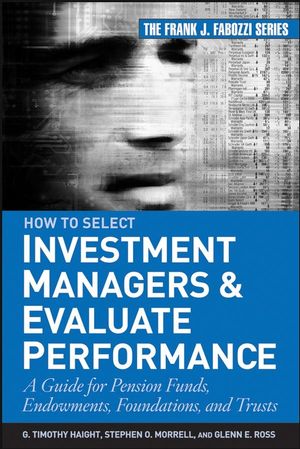How to Select Investment Managers and Evaluate Performance: A Guide for Pension Funds, Endowments, Foundations, and TrustsISBN: 978-0-470-04255-7
Hardcover
272 pages
October 2007
 This is a Print-on-Demand title. It will be printed specifically to fill your order. Please allow an additional 10-15 days delivery time. The book is not returnable.
|
||||||
Preface ix
About the Authors xi
CHAPTER 1 Investment Sponsors 1
The Investment Committee 4
The Variety of Investment Sponsors 7
Taxable Investment Sponsors 24
Summary 29
Chapter 2 Investment Policy Statement 31
Investment Philosophy and Goals 31
Investment Return Objectives 32
Risk Tolerances 32
Constraints 33
Investment Strategy 33
In-House or Outside Manager 34
Investment Policy 34
Securities Types and Risk Characteristics 35
Asset Allocation Guidelines 39
Evaluation of Performance 41
Benchmark Portfolios 51
Periodic Review 52
Summary 53
Chapter 3 Investment Overview 55
Capital Appreciation versus Current Income 55
Active versus Passive Investment Approaches 57
Investment Styles-Equity Managers 57
International Investing 65
Investment Styles-Fixed Income Managers 65
Summary 68
CHAPTER 4 Alternative Investment Vehicles 71
Hybrid Securities 72
Derivative Contracts 75
International Investment Vehicles 81
Real Estate Investment Vehicles 91
Investment Vehicles for Accredited Investors 93
Commodities and Collectibles 102
Summary 104
Chapter 5 Return Measures and Reporting Techniques 105
Dollar-Weighted Rate of Return 105
Time-Weighted Rate of Return 108
Annualized Rates of Return 110
Geometric Mean 111
Total Return and its Components 112
Compound Growth 115
Summary 118
Chapter 6 Return-Risk Measurement 119
Return Relative 119
Standard Deviation 121
Portfolio Risk Measure 124
Scatter Diagram 127
Coefficient of Variation 128
Regression Analysis 129
Portfolio Size and Diversification Levels 131
Regression Analysis of Fund I 132
Additional Performance Indexes 133
Summary 134
Chapter 7 Portfolio Performance Evaluation 137
Performance Results 138
Composite Index 139
Return Risk Analysis 140
Universe Comparison 141
Evaluating the Asset Allocation Decision 143
Summary 155
Chapter 8 Equity Performance Evaluation 157
Equity Performance Criteria 158
Sector Analysis 159
Return-Risk Comparison 163
Market Characteristics 164
Attribution Analysis 169
Summary 171
Chapter 9 Fixed Income Performance Evaluation 173
Asset Allocation Ranges and Anticipated Contributions 174
Issuers of Fixed Income Securities 174
Bond Indexes 176
Bond Prices and Yields 177
Term Structure of Interest Rates 180
Quality of Fixed Income Securities 181
Credit Risk 181
Interest Rate Risk 184
Duration 186
Convexity 189
Maturity Characteristics 191
Return Analysis 191
CFA Institute Standards 195
Fixed Income Management Styles 196
Passive Fixed Income Management 196
Active Fixed Income Management 198
Performance Analysis 199
Summary 202
CHAPTER 10 Investment Companies as Investment Vehicles 203
Investment Companies 205
Regulation of Investment Companies 207
Types of Investment Companies 208
Selecting Mutual Funds 215
Performance Evaluation 216
Summary 217
Chapter 11 Investment Manager Search Process 219
Search Committee 219
Establishing Goals 220
Number of Managers 220
Candidate Identification 222
Management and Related Fees 223
Firm Size and Ownership 225
Request for Proposals (RFP) 225
Screening of Candidates 230
Candidates Presentations 234
Verification and Reference Checking 236
Cost of Switching 239
Administration of Change 240
Summary 240
Chapter 12 Conducting Investment Committee Meetings 243
Meeting Preparations 243
Agenda and Meeting Materials 245
Setting the Agenda 245
Responsibilities of the Chairperson 246
Investment Consulting Services 246
Investment Performance Review and Outlook 247
Old Business 250
New Business 251
Summary 251
Index 809



